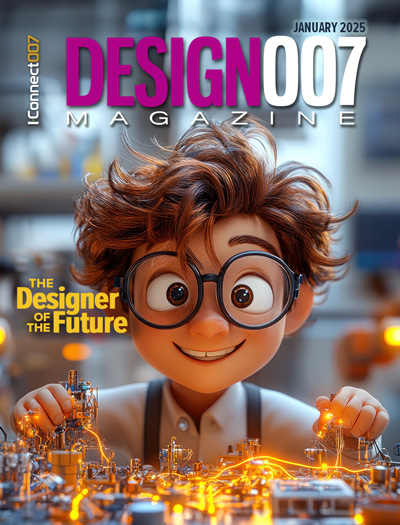-

-
News
News Highlights
- Books
Featured Books
- design007 Magazine
Latest Issues
Current Issue
Learning to Speak ‘Fab’
Our expert contributors clear up many of the miscommunication problems between PCB designers and their fab and assembly stakeholders. As you will see, a little extra planning early in the design cycle can go a long way toward maintaining open lines of communication with the fab and assembly folks.

Training New Designers
Where will we find the next generation of PCB designers and design engineers? Once we locate them, how will we train and educate them? What will PCB designers of the future need to master to deal with tomorrow’s technology?

The Designer of the Future
Our expert contributors peer into their crystal balls and offer their thoughts on the designers and design engineers of tomorrow, and what their jobs will look like.
- Articles
- Columns
Search Console
- Links
- Media kit
||| MENU - design007 Magazine
Estimated reading time: Less than a minute
Controlled Impedance Design
Controlled impedance—it’s all about transmission lines. For perfect transfer of energy, the impedance of the driver must match the transmission line. A good transmission line is one that has constant impedance along the entire length of the line, so that there are no mismatches resulting in reflections. But unfortunately, drivers do not have the exact impedance to match the line (typically 10–35 ohms) so terminations are used to balance the impedance, match the line and minimize reflections.
Reflections occur whenever the impedance of the transmission line changes along its length. This can be caused by unmatched drivers/loads, layer transitions, different dielectric materials, stubs, vias, connectors and IC packages. By understanding the causes of these reflections and eliminating the source of the mismatch, a design can be engineered with reliable performance.
Impedance matching slows down the rise and fall times, reduces the ringing (over/undershoot) of clock drivers and enhances the signal quality of a high-speed design. The ringing is dramatically reduced by adding a series terminator.
To read this article, which appeared in the May 2015 issue of The PCB Design Magazine, click here.
More Columns from Beyond Design
Beyond Design: Key SI Considerations for High-speed PCB DesignBeyond Design: Electro-optical Circuit Boards
Beyond Design: AI-driven Inverse Stackup Optimization
Beyond Design: High-speed Rules of Thumb
Beyond Design: Integrated Circuit to PCB Integration
Beyond Design: Does Current Deliver the Energy in a Circuit?
Beyond Design: Termination Planning
Beyond Design: Dielectric Material Selection Guide


